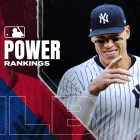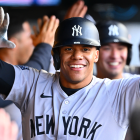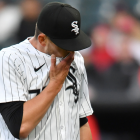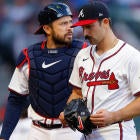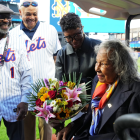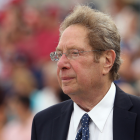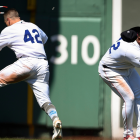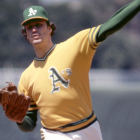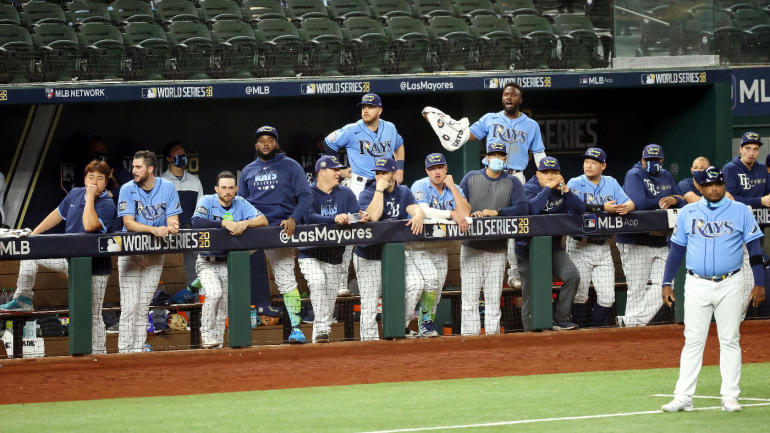
After coming within two wins of the first World Series title in franchise history, the Tampa Bay Rays now head into an offseason that figures to be frugal even by their own concept-defining standards. Once again, threading the needle between contention and maximizing profits for owner Stuart Sternberg -- with an emphasis on the latter -- will be the challenge.
Speaking of Rays' spending, there's a recent history of very damned little of it. Here's how the Rays have ranked among MLB's 30 clubs in Opening Day payroll over the last five years (data via Baseball Prospectus/Cot's Contracts):
| Season | Rays' Opening Day payroll rank (out of 30) |
|---|---|
2020 | 28th |
2019 | 30th |
2018 | 28th |
2017 | 28th |
2016 | 29th |
Even though a championship-caliber roster is self-evidently in place, there's no reason to think this is going to change. The Rays are still in a holding pattern when it comes to their long-term future in the Tampa/St. Petersburg region, and of course there are the financial strains of the ongoing COVID-19 pandemic. The 2020 regular season was whittled down to 60 games, and no fans were allowed to attend games until the later rounds of the playoffs. While the Rays aren't particularly reliant on gate revenues -- and while there's no reason to believe claims of league-wide losses amounting to $3 billion -- that's still a blow to the balance sheet. On another level, the Rays just won the pennant despite a basement-level payroll, which provides the C suite with the tidy rationale to continue running basement-level payrolls.
Given the recent organizational bent and loss of expected revenues, the issue becomes how the Rays can best shed payroll heading into 2021. That brings us to their most significant salary obligations for next season:
- CF Kevin Kiermaier is owed $11.17 million.
- LHP Blake Snell is owed $11.1 million.
- INF/OF Brandon Lowe is owed $2.5 million.
- RHP Chaz Roe is arbitration-eligible for the third time.
- OF Manuel Margot is arbitration-eligible for the second time.
- OF Hunter Renfroe, 1B Ji-Man Choi, RHP Tyler Glasnow, INF Joey Wendle, and LHP Jose Alvarado will all be first-year arbitration eligible.
As well, the Rays declined a $15 million option on veteran right-hander Charlie Morton. It's possible the Rays and Morton agree to a lower salary, but it seems more likely that the soon-to-be 37-year-old signs elsewhere or retires after 12 major-league seasons. Yes, Morton made $15 million this past season, but it was always unlikely that the Rays would opt into such a commitment for 2021.
The next biggest path to salary relief would be trading Kiermaier or Snell. The market would be much stronger for Snell, the 2018 AL Cy Young winner who's not yet 28 years old, which means the Rays could expect a much stronger package in return. This isn't to predict that a Snell trade is in offing; it's just to say it's one path to sloughing off payroll commitments. The guess here, however, is that the Rays hang onto Snell since all signs point to them parting ways with Morton.
Elsewhere, MLB Trade Rumors projects that Glasnow and Renfroe will fetch the highest arb-eligible salaries on the roster, at $5.1 million and $4.3 million, respectively. Renfroe, who doesn't have a clear path to playing time anyway, may not be back in St. Pete next year.
So where does that leave the Rays? There's still plenty of talent on the roster. Lowe, Glasnow, Randy Arozarena, and Willy Adames all figure to be productive contributors in 2021, and Austin Meadows has at least some bounceback potential. Right-hander Brent Honeywell, a former top prospect, may also be able to contribute next season, and lefty Brendan McKay should be back from shoulder woes. High-upside Infield prospects Vidal Brujan and Wander Franco also may hit the bigs at some point in 2021 and provide immediate impact. In Franco's case, he's the consensus top prospect in all of baseball and has superstar potential.
On another level, it must be stated that the Rays were probably a bit lucky in 2020 to win at a .667 clip (40-20), which scales to a 108-win pace across the usual 162 games. Look at their run differential, however, and they had a deserved record of 36-24. A four-game divide is quite a large disconnect across a sample of just 60 games. According to the BaseRuns system at FanGraphs, which evaluates how many runs a team should have scored and allowed based on their underlying fundamental indicators, the Rays had a deserved record of 35-25. Obviously, it's the actual standings that count, but run differential and BaseRuns are better gauges of a team's performance baseline moving forward.
All of this leaves the Rays likely poised for contention yet again. While the 2020 team perhaps wasn't as sustainably good as its record, this remains a squad that over the last three seasons has gone 226-158, and the talent pipeline is still flowing well. Maybe the Rays' front office gets too clever by half in the name of cutting payroll, but the talent that figures to be back in 2021 and arriving soon is enough to put them squarely in the postseason mix yet again. That, in turn, means another shot at winning that first World Series in franchise history.














